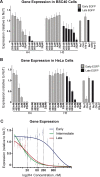Inhibition of Poxvirus Gene Expression and Genome Replication by Bisbenzimide Derivatives
- PMID: 28659488
- PMCID: PMC5571260
- DOI: 10.1128/JVI.00838-17
Inhibition of Poxvirus Gene Expression and Genome Replication by Bisbenzimide Derivatives
Abstract
Virus infection of humans and livestock can be devastating for individuals and populations, sometimes resulting in large economic and societal impact. Prevention of virus disease by vaccination or antiviral agents is difficult to achieve. A notable exception was the eradication of human smallpox by vaccination over 30 years ago. Today, humans and animals remain susceptible to poxvirus infections, including zoonotic poxvirus transmission. Here we identified a small molecule, bisbenzimide (bisbenzimidazole), and its derivatives as potent agents against prototypic poxvirus infection in cell culture. We show that bisbenzimide derivatives, which preferentially bind the minor groove of double-stranded DNA, inhibit vaccinia virus infection by blocking viral DNA replication and abrogating postreplicative intermediate and late gene transcription. The bisbenzimide derivatives are potent against vaccinia virus and other poxviruses but ineffective against a range of other DNA and RNA viruses. The bisbenzimide derivatives are the first inhibitors of their class, which appear to directly target the viral genome without affecting cell viability.IMPORTANCE Smallpox was one of the most devastating diseases in human history until it was eradicated by a worldwide vaccination campaign. Due to discontinuation of routine vaccination more than 30 years ago, the majority of today's human population remains susceptible to infection with poxviruses. Here we present a family of bisbenzimide (bisbenzimidazole) derivatives, known as Hoechst nuclear stains, with high potency against poxvirus infection. Results from a variety of assays used to dissect the poxvirus life cycle demonstrate that bisbenzimides inhibit viral gene expression and genome replication. These findings can lead to the development of novel antiviral drugs that target viral genomes and block viral replication.
Keywords: DNA replication; antiviral agents; poxvirus; vaccinia virus; viral transcription.
Copyright © 2017 Yakimovich et al.
Figures







Similar articles
-
Bisbenzimide compounds inhibit the replication of prototype and pandemic potential poxviruses.Microbiol Spectr. 2024 Apr 2;12(4):e0407223. doi: 10.1128/spectrum.04072-23. Epub 2024 Feb 20. Microbiol Spectr. 2024. PMID: 38376353 Free PMC article.
-
Nigericin is a potent inhibitor of the early stage of vaccinia virus replication.Antiviral Res. 2010 Dec;88(3):304-10. doi: 10.1016/j.antiviral.2010.10.001. Epub 2010 Oct 15. Antiviral Res. 2010. PMID: 20951746 Free PMC article.
-
Suppression of poxvirus replication by SC144.Antiviral Res. 2025 Aug;240:106204. doi: 10.1016/j.antiviral.2025.106204. Epub 2025 May 29. Antiviral Res. 2025. PMID: 40449737
-
Vaccinia virus inhibitors as a paradigm for the chemotherapy of poxvirus infections.Clin Microbiol Rev. 2001 Apr;14(2):382-97. doi: 10.1128/CMR.14.2.382-397.2001. Clin Microbiol Rev. 2001. PMID: 11292644 Free PMC article. Review.
-
[Poxvirus-encoded DNA replication proteins: potential targets for antivirals].Virologie (Montrouge). 2024 Feb 1;28(1):23-35. doi: 10.1684/vir.2024.1033. Virologie (Montrouge). 2024. PMID: 38450665 Review. French.
Cited by
-
Comparative in silico study of congocidine congeners as potential inhibitors of African swine fever virus.PLoS One. 2019 Aug 28;14(8):e0221175. doi: 10.1371/journal.pone.0221175. eCollection 2019. PLoS One. 2019. PMID: 31461446 Free PMC article.
-
Fluorescent Clade IIb Lineage B.1 Mpox Viruses for Antiviral Screening.Viruses. 2025 Feb 13;17(2):253. doi: 10.3390/v17020253. Viruses. 2025. PMID: 40007008 Free PMC article.
-
Microscopy deep learning predicts virus infections and reveals mechanics of lytic-infected cells.iScience. 2021 May 15;24(6):102543. doi: 10.1016/j.isci.2021.102543. eCollection 2021 Jun 25. iScience. 2021. PMID: 34151222 Free PMC article.
-
A Spotlight on Viruses-Application of Click Chemistry to Visualize Virus-Cell Interactions.Molecules. 2019 Jan 29;24(3):481. doi: 10.3390/molecules24030481. Molecules. 2019. PMID: 30700005 Free PMC article. Review.
-
Concepts in Light Microscopy of Viruses.Viruses. 2018 Apr 18;10(4):202. doi: 10.3390/v10040202. Viruses. 2018. PMID: 29670029 Free PMC article. Review.
References
Publication types
MeSH terms
Substances
Grants and funding
LinkOut - more resources
Full Text Sources
Other Literature Sources

